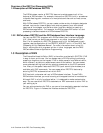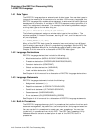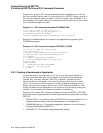Overview of the DEC Text Processing Utility
1.4 DECTPU Language
1.4.5 User-Written Procedures
You can write your own procedures that combine DECTPU language statements
and calls to DECTPU built-in procedures. DECTPU procedures can return values
and can be recursive. After you write a procedure and compile it, you use the
procedure name to invoke it.
When writing a procedure, use the following guidelines:
• Start each procedure with the word PROCEDURE, followed by the procedure
name of your choice.
• End each procedure with the word ENDPROCEDURE.
• Place a semicolon after each statement or built-in call if the statement or call
is followed by another statement or call.
If the statement or call is not followed by another statement or call, the
semicolon is not necessary.
Example 1–1 is a sample procedure that uses the DECTPU language statements
PROCEDURE/ENDPROCEDURE and the built-in procedures POSITION,
BEGINNING_OF, and CURRENT_BUFFER to move the current character
position to the beginning of the current buffer. The procedure uses the MESSAGE
built-in to display a message; it uses the GET_INFO built-in to get the name of
the current buffer.
Example 1–1 Sample User-Written Procedure
! This procedure moves the editing
! position to the top of the buffer
PROCEDURE user_top
POSITION (BEGINNING_OF (CURRENT_BUFFER));
MESSAGE ("Now in buffer" + GET_INFO (CURRENT_BUFFER, "name"));
ENDPROCEDURE;
Once you have compiled this procedure, you can invoke it with the name user_top.
For information about writing procedures, see Chapter 4 and Chapter 5.
1.5 Terminals Supported by DECTPU
DECTPU runs on all VAX and Alpha computers, and supports screen-oriented
editing on the Compaq VT400-, VT300-, VT200-, and VT100-series terminals, as
well as on other video display terminals that respond to ANSI control functions.
Optimum screen-oriented editing performance occurs when you run DECTPU
from VT400-series, VT300-series, VT220-series, and VT100-series terminals.
Some video terminal hardware does not have optimum DECTPU performance.
See Appendix B for a list of hardware characteristics that may adversely affect
DECTPU’s performance.
Although you cannot use the screen-oriented features of DECTPU on a VT52
terminal, hardcopy terminal, or foreign terminal that does not respond to ANSI
control functions, you can run DECTPU on these terminals with line-mode
editing. For information on how to implement this style of editing, see the
description of the /NODISPLAY qualifier in Chapter 2 and the sample line-mode
editor in Appendix A.
Overview of the DEC Text Processing Utility 1–7


















